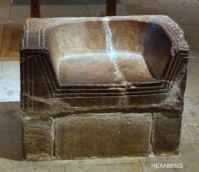 Click on
Click onThumbnail
for
8 photos+
Underneath this is the apse of the east end of a Saxon building.
This may have been a small chapel built in line with the larger church.
church. As Hexham was not made a See until some years after the church had been built, the “frith stool” is probably an introduction of the time when Wilfrid sat as Bishop of Hexham. On the other hand it may be argued, that as St Wilfrid obtained for his church the privilege of sanctuary, in connection with which the “frith stool” was used, it was made for that purpose. It was so used during the Middle Ages, and probably from the time when Hexham ceased to be the seat of a bishopric. The stool is cut from a single block of stone, and was mounted on another stone. At a later period a moulding was added beneath the block forming the seat; this moulding has now been destroyed and the seat is mounted on a base built up of several stones. The drawings on Plate 35 sufficiently illustrate this curious relic. The distinctly classical feeling of the design will be observed, and this favours the opinion held by the Reverend G P Browne that it was modelled after some similar chair in Rome, which St Wilfrid had seen. It is worthy of remark that the triquetra knots in the ornamentation of the arms are not joined to the twisted bands, but are quite independent of them. The appearance of the back, and of one side, is such as to lead us to suppose that the stool was originally placed in an angle, and that these two faces were against adjacent walls. [Hadcock 1935 plan no.6]
1795: Carter's drawing “Stone chair …” [MS_29933_0061] shows the crack in the Frith Stool; presumably it was re-broken when moved in 1859.
1864: “Beyond the highest limit to which living memory can extend, and most probably for six centuries more, that most venerable monument of antiquity, the well-known Frith-stool of Hexham, used before the Reformation for the unassailable security of persons seeking the sanctuary of the church, occupied a position immediately in front of the last pillar, eastward, on the north side of the choir, its face being turned towards the south. Soon after the year 1830, however, when the church was re-pewed, neither the unusual local interest which attached to it, nor the fact of its being an almost unique example of its kind, could preserve it from removal into the north aisle, immediately behind the pillar in front of which it had previously stood. Hence it was again recently removed, and placed, where it now stands, in the aisle of the south transept, at the angle of its junction with the contiguous aisle of the choir.” [Raine, Preface II p.lxv]
The “frith stool” has had a chequered history, and has been frequently moved. At the close of the last [18th] century it was placed in front of the first column from the east on the north side of the choir. It is shown in this position on the plate, and there can be little doubt that this was the place it occupied during the Middle Ages, for we are told by Prior Richard that it stood “against the altar”. When the choir was re-pewed in 1830 the “frith stool” was moved and placed in the north aisle behind Prior Leschman's chantry. It remained there till 1859, when all the ancient arrangements of the chancel were destroyed. It was then moved and placed in the aisle of the south transept [north end]. On this occasion the moulding under the seat was destroyed, and the seat was broken into two pieces. Carelessness and total indifference to the value of the ancient remains, was one of the most conspicuous features of that terribly destructive movement. In 1872 the “frith stool” was restored to its ancient position in the choir, but was not long allowed to remain in peace, for in 1885 it was again moved, and placed on the south side of the communion table, with its back against the east wall, a position to which it is quite unsuited, and where it is not seen to advantage. It is greatly to be desired that this valuable and unique relic of past days be once more placed in its ancient position, and be there allowed to remain. [Hodges 1888 p21]. Drawn [HEXAB3028] by Hodges.
‘The “Frith Stool” in which St Wilfrid sat is now fittingly placed on the north side of the sanctuary, and was, to the delight of us all, most fittingly occupied on Saturday by the venerable Archbishop of York, Wilfrid's true successor.’ [The Church Times 14/08/1908 p190]
“The Frith Stool now stands [centre of Choir, above the Saxon apse] where it stood in the year 674. It looks most dignified. It is now visible to every visitor of the Abbey. It is, of course, the most deeply interesting piece of furniture that we possess. It may well be the envy of continents and countries.” [Hex.Par.Mag. Sep 1909 p50]
HAR: fn.14 p.74
1907. 21st day of November. … 10. The replacing of the ancient Frith Stool on the north side of the re-arranged choir in front of the restored Leschman Chantry. … Faculty reg. no.1. Faculty no.316. NRO EP.184/80. Hex. Parish Mag. Dec. 1907, p.91.
1909. 21st day of July. … To remove [from outside the Leschman Chantry] the Frith Stool to the place above the site of the Saxon apse. Faculty reg. no.1. Faculty no.356. NRO EP.184/80.